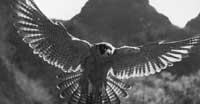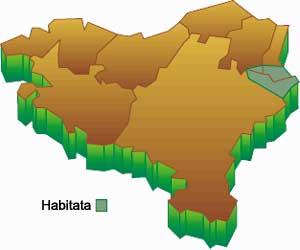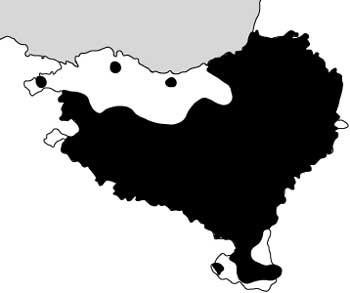Kestrel
1994/04/01 Aihartza, Joxerra Iturria: Elhuyar aldizkaria
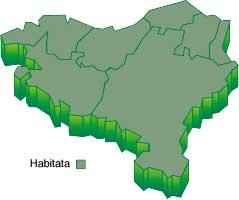
To those who by gravity effect are doomed to drag their feet stuck to the ground, seeing birds fly always produces an incredible envy and emotion. But this feeling is heightened if you can see the action of the red hawk: waving at full speed the wings in the static air, you look at the earth in search of a piece of game in balance. The rapid vibration of the ends of the hillside holds firm on our head, as if it were hung from an invisible cord, cutting from blow to blow, moving in sliding to another area where it rebalances. In space it stands firm as flies do in summer. Forgotten of Newton's law, he seems to mock the impotence of our grave dresses.
The peregrine falcon (Falco tinnunculus) is a slender bird of prey classified in the order of the falconiform. As for its appearance, it is somewhat smaller than the dove, with a length of between 31 and 38 cm and a width of 70-80 cm wings. Like the rest of the hawks, the red hawk features sharp fins and a long and elegant tail that takes on an ancestral appearance in flight. On the face, under the eyes and on both sides of the beak, very clear black signs appear as “whiskers”.
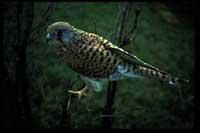
On the other hand, and as its name clearly indicates, the red hawk is a bird dressed in reddish brown plumage painted in black, which is seen above all in the dorsal area. As in the rest of predators, in the red hawk sexual dimorphism is very evident, being females quite older than males. In addition, this dimorphism is easily appreciated in the coloring of the animal: while the females have a homogeneous dorsal coloration, in the case of the males the back and the upper wings are reddish brown and painted black, yes, but with the head and gray tail bluish, with the ends of the wings dressed in black.
The red hawk is an easily recognized bird in flight. And it is that, in addition to the black footprint that carries as an ornament in the caudal end, its way of flying is not too fast, nor too high, and it is composed of rapid alloys, very characteristic if we compare it with the rest of skirts.
But its ability to keep in balance with the vibrating fins is, logically, the most characteristic feature of the flight of the red hawk, the ability that best separates from the rest of the hawks that inhabit our environment. Thus, while the peregrine falcon ("Falco peregrinus") is, above all, a sharp, fast and powerful aletero, adapted to hit and catch the rest of birds in the air, the red hawk ("Falco tinnunculus") is a magnificent specialist who lives on the capture of small pieces of hunting on earth, a profession in which the ability to keep in balance with a strict primo look that is much faster than good.
The zeal of this small predator who normally lives in couples or family groups begins with wedding flights in March or early April. The peregrine falcon, however, does not nest, and other birds built in the previous year, or uses ferments or stretches of rock to throw new chickens, always with rocky cliffs, slopes, churches or other ancient and quiet human constructions. You can also periodically choose trees for this important work.
In the appropriate nests, that is, in which in addition to offering low human pressure and sufficient security, they are near the areas suitable for hunting, several couples can be found nesting in which there are no major disturbances between them. And it is that, although the red hawk imposes a terrible territoriality, this is always of short radius, and it is imminent the separation of the rocky cliff, slope, etc., in which couples are matched, although from that moment it will be work to maintain the limits established between the couples.
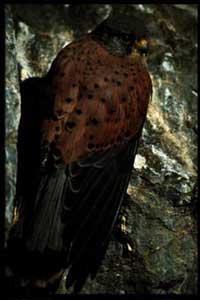
In April the female lays four or five eggs (six for periods) and in the next 27-30 days will be in charge of drowning them, being at that time the male the job of getting a fodder for both. Therefore, for more than a month the male must hunt rats, rats, moles, satitsu, mole, lizard, lizard, insects, etc. After the birth of the chickens, and after the first week of the 27-32 days that will pass through the nest, the hunting work is done with males and females.
And in that sense, in addition to the hunting pieces until then, the red hawks are thrown into the exploitation of the accustomed chicks of the nests of the other birds and the naive ones who are learning to fly, in a futile attempt to alleviate the hunger of their insatiable twinks. Undoubtedly, at this time the couples of red hawks become great consumers of micromammals, small reptiles, insects and small birds that inhabit the mountain, becoming a demanding limiting of the fertility of their populations.
The Red Hawk is a practically omnipresent species (both in Africa and throughout Eurasia) that has a very wide distribution in Europe, from the Mediterranean to Scandinavia (up to 68º north latitude), being sedentary in almost the entire territory (except in the north).
In the case of Euskal Herria, the red hawk is a sedentary predator, very widespread and abundant, present in almost all types of habitats. In winter, for its part, the indigenous and sustainable population is completed with migrants from northern Europe, who remain as winterers mainly in the Bardenas and in the vicinity of the Ebro River.
Currently, pesticides pose a serious danger to the red hawk, although the situation of this species has improved markedly since the beginning of the fall of poaching, nest thefts and other unfair activities, facilitating its solution by the broad trophic opportunism of the red hawk and its scarce specialization in nesting sites. For this reason, in recent years we are witnessing a growing presence of the red hawk, both in cities and in the rest of humanized areas, such as industrial areas of Greater Bilbao, landfill areas, old quarries, etc.
Species: Falco tinnunculus Family: falconidos Order: falconiformes Class: birds |

Gai honi buruzko eduki gehiago
Elhuyarrek garatutako teknologia




